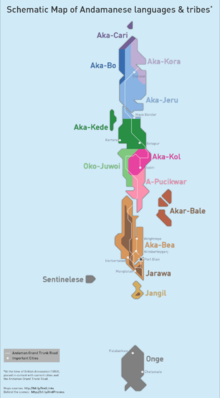Aka-Kora language
The Kora (Cora) language, Aka-Kora, is an extinct Great Andamanese language, of the Northern group. It was spoken on the northeast and north central coasts of North Andaman and on Smith Island.
| Kora | |
|---|---|
| Aka-Kora | |
| Native to | India |
| Region | Andaman Islands; northeast and north central coasts of North Andaman Island, Smith Island |
| Ethnicity | Kora |
| Extinct | November 2009, with the death of Boro[1] |
Great Andamanese
| |
| Language codes | |
| ISO 639-3 | ack |
| Glottolog | akak1251 |
 | |
It has been extinct since November 2009 when its last speaker, Boro, died.[1]
NameEdit
The native name for the language was Aka-Kora, also spelled Aka-Khora or Aka-Cora (Aka- being a prefix for "tongue"); and this name is often used for the tribe itself. They were divided between shore-dwellers (aryoto) and forest-dwellers (eremtaga) subtribes.[2]
HistoryEdit
By the time of the establishment of the first permanent colonial settlement at Port Blair (1858), the estimates size of the Kora tribe was about 500 individuals, out of perhaps 3500 Great Andamanese.[3] However the tribe was discovered only much later, in the work leading to the 1901 census.[3] Like other Andamanese peoples, the Kora were decimated during colonial and post-colonial times, by diseases, alcohol, opium and loss of territory. The census of 1901 recorded 96 individuals, which decreased to 71 in 1911, 48 in 1921, and 24 in 1931.[3]
In 1949, any remaining Kora were relocated, with all other surviving Great Andamanese, to a reservation on Bluff island.[4] In 1969 they were relocated again to a reservation on Strait Island.[4]
By 1980 only one person claimed to be a Kora member,[2] and 1994 the Kora tribe no longer existed as a separate unit.[5] Although descendants of the Kora were still living in the Great Andamanese reservation of Strait Island as of 2006, they identified themselves as members of other tribes, mainly Jeru.[6] The last known speaker of the Kora language died in November 2009.[6] They were a designated Scheduled Tribe.[7]
GrammarEdit
The Great Andamanese languages are agglutinative languages, with an extensive prefix and suffix system.[8] They have a distinctive noun class system based largely on body parts, in which every noun and adjective may take a prefix according to which body part it is associated with (on the basis of shape, or functional association). Thus, for instance, the *aka- at the beginning of the language names is a prefix for objects related to the tongue.[8] An adjectival example can be given by the various forms of yop, "pliable, soft", in Aka-Bea:[8]
- A cushion or sponge is ot-yop "round-soft", from the prefix attached to words relating to the head or heart.
- A cane is ôto-yop, "pliable", from a prefix for long things.
- A stick or pencil is aka-yop, "pointed", from the tongue prefix.
- A fallen tree is ar-yop, "rotten", from the prefix for limbs or upright things.
Similarly, beri-nga "good" yields:
- un-bēri-ŋa "clever" (hand-good).
- ig-bēri-ŋa "sharp-sighted" (eye-good).
- aka-bēri-ŋa "good at languages" (tongue-good.)
- ot-bēri-ŋa "virtuous" (head/heart-good)
The prefixes are,
| Bea | Balawa? | Bajigyâs? | Juwoi | Kol | |
|---|---|---|---|---|---|
| head/heart | ot- | ôt- | ote- | ôto- | ôto- |
| hand/foot | ong- | ong- | ong- | ôn- | ôn- |
| mouth/tongue | âkà- | aka- | o- | ókô- | o- |
| torso (shoulder to shins) | ab- | ab- | ab- | a- | o- |
| eye/face/arm/breast | i-, ig- | id- | ir- | re- | er- |
| back/leg/butt | ar- | ar- | ar- | ra- | a- |
| waist | ôto- |
Body parts are inalienably possessed, requiring a possessive adjective prefix to complete them, so one cannot say "head" alone, but only "my, or his, or your, etc. head".
The basic pronouns are almost identical throughout the Great Andamanese languages; Aka-Bea will serve as a representative example (pronouns given in their basic prefixal forms):
| I, my | d- | we, our | m- |
| thou, thy | ŋ- | you, your | ŋ- |
| he, his, she, her, it, its | a | they, their | l- |
'This' and 'that' are distinguished as k- and t-.
Judging from the available sources, the Andamanese languages have only two cardinal numbers — one and two — and their entire numerical lexicon is one, two, one more, some more, and all.[8]
ReferencesEdit
- ↑ 1.0 1.1 "Andamanese tribes, languages die". The Hindu. February 5, 2010. Retrieved 2010-02-05.
- ↑ 2.0 2.1 George Weber (~2009), The Tribes Archived 2013-05-07 at the Wayback Machine. Chapter 8 in The Andamanese Archived 2012-08-05 at the Wayback Machine. Accessed on 2012-07-12.
- ↑ 3.0 3.1 3.2 George Weber (~2009), Numbers Archived May 31, 2012, at the Wayback Machine. Chapter 7 in The Andamanese Archived 2012-08-05 at the Wayback Machine. Accessed on 2012-07-12.
- ↑ 4.0 4.1 Rann Singh Mann (2005), Andaman and Nicobar Tribes Restudied: Encounters and Concerns, page 149. Mittal Publications. ISBN 81-8324-010-0
- ↑ A. N. Sharma (2003), Tribal Development in the Andaman Islands, page 75. Sarup & Sons, New Delhi.
- ↑ 6.0 6.1 Anvita Abbi (2006), Great Andamanese Community in VOGA - Vanishing Voices of the Great Andamanese. Accessed on 2012-07-12.
- ↑ "List of notified Scheduled Tribes" (PDF). Census India. p. 27. Archived from the original (PDF) on 7 November 2013. Retrieved 15 December 2013.
- ↑ 8.0 8.1 8.2 8.3 Temple, Richard C. (1902). A Grammar of the Andamanese Languages, being Chapter IV of Part I of the Census Report on the Andaman and Nicobar Islands. Superintendent's Printing Press: Port Blair.